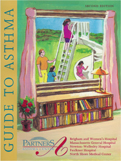Guide to Asthma
Practice Session #1 ("The Head Cold"):
Imagine that your asthma has been generally well controlled. As your preventer medicine you take a steroid inhaler (4 puffs twice daily). Most days you do not need your quick-relief bronchodilator (albuterol inhaler) at all. Other days you use it perhaps once or at most twice in a day, although you always carry it with you.
Last week you had a head cold, as did other members of your family. You had a low-grade fever for two days, with sore throat and nasal congestion. Earlier this week your cold seemed to improve, but you started coughing a lot. Last night you were awakened repeatedly with coughing and slept much of the night propped up on pillows. You used the albuterol inhaler twice overnight with some relief.
Today you are still coughing and raising clear phlegm (like "egg white"). In addition, you find yourself short of breath with even light exertion, such as walking 50 feet. You use your albuterol inhaler again, but it doesn’t seem to help for more than about 5 minutes. Your check your peak flow with your peak flow meter. You are dismayed to find that your peak flow is only 180 liters per minute, less that half of your usual (400 L/min).
What would you do next?
Discussion:
The first point is to recognize that this episode is more than just a bad "cold." It is a severe asthma attack. It is not normal for a routine chest infection to cause shortness of breath when one walks only a short distance. In this example a head and chest cold has set off a flare of the underlying asthma. The low peak flow value, less than half of the usual best value, confirms that this is a severe attack.
If you have a compressor and nebulizer at home, this would be a good time to use them to deliver a quick-relief bronchodilator (such as albuterol) by continuous mist. If you don’t have a compressor and nebulizer, use your quick-relief bronchodilator inhaler with a spacer (to maximize delivery of the medication to the airways) and take 4 puffs, each spaced one minute apart. If you don’t have a spacer with you, use the inhaler as carefully as you can without one. You can continue to take your quick-relief bronchodilator (by nebulizer or by inhaler) every 20 minutes for 1-2 hours if needed.
It would be a mistake to rely solely on your bronchodilator medicine for treatment of a severe asthma attack. If you continue to have intense asthma symptoms after using your bronchodilator 2-3 times, you can be certain that a major part of the problem is swelling of the bronchial tubes and filling up of the bronchial tubes with mucus. The air passageways are severely inflamed, and no amount of bronchodilator alone will treat this part of the problem. The treatment for swelling and inflammation of the bronchial tubes is corticosteroids ("steroids").
When you are having a severe attack like this one, it is generally necessary to take steroids by mouth as tablets. Your doctor will likely want to prescribe prednisone or methylprednisolone (Medrol®). You should call your doctor (or covering physician) emergently to discuss your condition and likely get a prescription for oral steroid tablets. It will be particularly helpful if you can tell your health care provider what your peak flow value is. This information will help him or her to gauge how bad this attack is and how best to respond to it.
If you previously have had a severe attack of asthma, your doctor may have given you some steroid tablets to have at home; this would be a good time to take some, perhaps 30-60 milligrams. You should also plan to notify your doctor that you are ill and that you have begun a course of steroid tablets.
Steroid tablets usually take several hours (2-6 hours) to exert an effect. You can continue to use your bronchodilator (for example, albuterol inhaler) as often as every hour while waiting for the steroids to take effect. You should rest and relax as much as possible. As long as your breathing (and peak flow) are steady or improving during this time, you will do fine.
On the other hand, if your breathing is getting worse, you will need to seek emergency help. Quickly get to a nearby urgent care center or emergency room. A severe asthma attack can be dangerous, especially if you are getting worse despite frequent use of your bronchodilator. Indicators that would make you or a family member want to call 911 for an emergency rescue team might include the following: unable to speak more than a word or two because of shortness of breath, passing out or nearly passing out, bluish discoloration of the lips and skin due to lack of oxygen, and peak flow less than 100 liters per minute.

